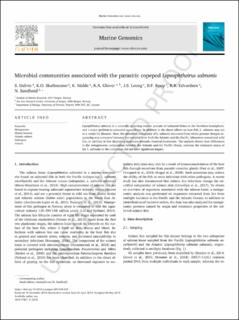| dc.contributor.author | Dalvin, Sussie | |
| dc.contributor.author | Skaftnesmo, Kai Ove | |
| dc.contributor.author | Malde, Ketil | |
| dc.contributor.author | Glover, Kevin | |
| dc.contributor.author | Leong, Jong S | |
| dc.contributor.author | Koop, Ben F. | |
| dc.contributor.author | Edvardsen, Rolf Brudvik | |
| dc.contributor.author | Sandlund, Nina | |
| dc.date.accessioned | 2021-01-14T09:28:24Z | |
| dc.date.available | 2021-01-14T09:28:24Z | |
| dc.date.created | 2019-11-01T09:03:02Z | |
| dc.date.issued | 2019 | |
| dc.identifier.citation | Marine Genomics. 2020, 49 . | en_US |
| dc.identifier.issn | 1874-7787 | |
| dc.identifier.uri | https://hdl.handle.net/11250/2722941 | |
| dc.description.abstract | Lepeophtheirus salmonis is a naturally occurring marine parasite of salmonid fishes in the Northern hemisphere, and a major problem in salmonid aquaculture. In addition to the direct effects on host fish, L. salmonis may act as a vector for diseases. Here, the microbial community of L. salmonis recovered from whole genome shotgun sequencing was compared between lice sampled from both the Atlantic and the Pacific, laboratory-reared and wild lice, in addition to lice displaying resistance towards chemical treatments. The analysis shows clear differences in the metagenomic composition between the Atlantic and the Pacific Ocean, whereas the resistance status of the L. salmonis or the cultivation did not have significant impact. | en_US |
| dc.language.iso | eng | en_US |
| dc.title | Microbial communities associated with the parasitic copepod Lepeophtheirus salmonis. | en_US |
| dc.type | Peer reviewed | en_US |
| dc.type | Journal article | en_US |
| dc.description.version | submittedVersion | en_US |
| dc.source.pagenumber | 4 | en_US |
| dc.source.volume | 49 | en_US |
| dc.source.journal | Marine Genomics | en_US |
| dc.identifier.doi | 10.1016/j.margen.2019.05.003 | |
| dc.identifier.cristin | 1743098 | |
| dc.relation.project | Havforskningsinstituttet: 14,501 | en_US |
| cristin.ispublished | true | |
| cristin.fulltext | preprint | |
| cristin.fulltext | preprint | |
| cristin.qualitycode | 1 | |
